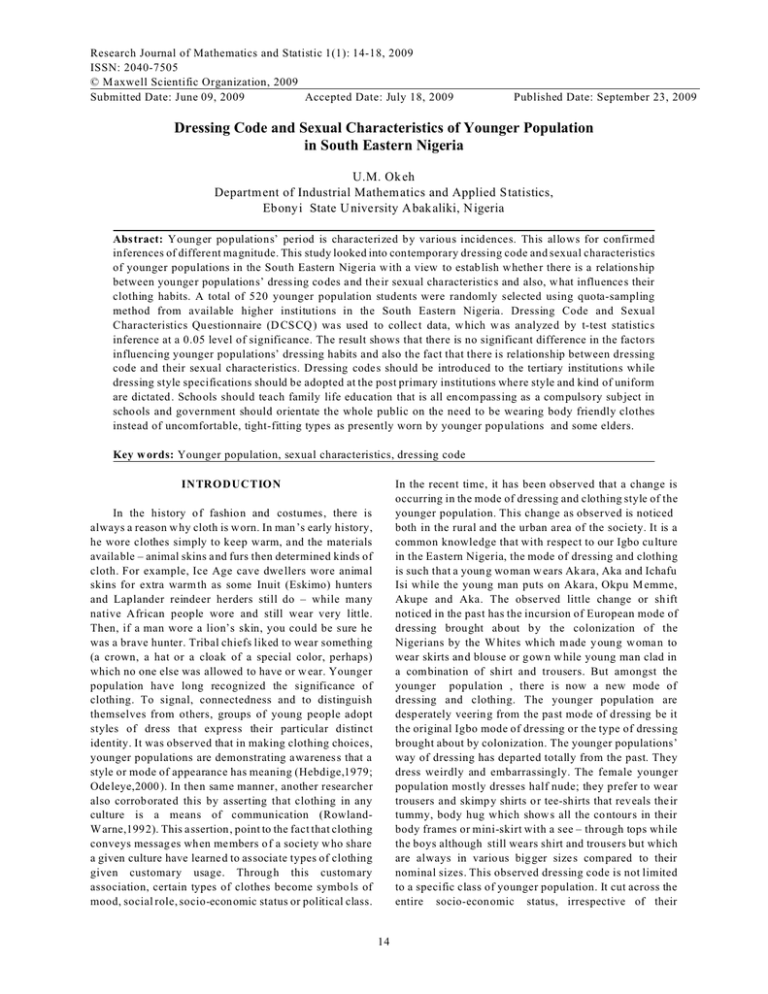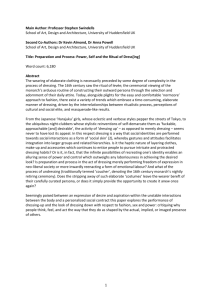
Research Journal of Mathematics and Statistic 1(1): 14-18, 2009
ISSN: 2040-7505
© M axwell Scientific Organization, 2009
Submitted Date: June 09, 2009
Accepted Date: July 18, 2009
Published Date: September 23, 2009
Dressing Code and Sexual Characteristics of Younger Population
in South Eastern Nigeria
U.M. Ok eh
Department of Industrial Mathem atics and Applied Statistics,
Ebony i State U niversity A bakaliki, N igeria
Abstract: Younger populations’ period is characterized by various incidences. This allows for confirmed
inferences of different magnitude. This study looked into contemporary dressing code and sexual characteristics
of younger populations in the South Eastern Nigeria w ith a view to estab lish whethe r there is a relationship
between younger populations’ dressing co des and the ir sexual characteristics and also, w hat influence s their
clothing habits. A total of 520 younger population students were randomly selected using quota-sampling
method from available higher institutions in the South Eastern Nigeria. Dressing Code and Sexual
Characteristics Questionnaire (D CSCQ ) was used to collec t data, w hich w as analyzed by t-test statistics
inference at a 0.05 level of significance. The result shows that there is no significant difference in the factors
influencing younger populations’ dressing habits and also the fact that there is relationship between dressing
code and their sexual characteristics. Dressing code s should be introdu ced to the tertiary institutions wh ile
dressing style specifications should be adopted at the post primary institutions where style and kind of uniform
are dictated . Scho ols should teach family life education that is all encom passing as a com pulsory sub ject in
scho ols and government should orientate the whole public on the need to be wearing body friendly clothes
instead of uncomfortable, tight-fitting types as presently worn by younger pop ulations and some elders.
Key w ords: Younger population, sexual characteristics, dressing code
In the recent time, it has been observed that a change is
occurring in the mode of dressing and clothing style of the
younger population. This change as observed is noticed
both in the rural and the urban area of the society. It is a
common knowledge that with respect to our Igbo cu lture
in the Eastern Nigeria, the mode of dressing and clothing
is such that a young wo man w ears Ak ara, Aka and Ichafu
Isi while the young man puts on Akara, Okpu M emme,
Akupe and Aka. The observed little change or sh ift
noticed in the past has the incursion of European mode of
dressing brought ab out by the colonization of the
Nigerians by the W hites which made y oung woma n to
wear skirts and blou se or gown while young man clad in
a com bination of shirt and trousers. But amongst the
younger population , there is now a new mode of
dressing and clothing. The younger population are
desp erately veering from the past mode of d ressing be it
the original Igbo mode of dressing or the type of dressing
brought about by colonization. The younger populations’
way of dressing has departed totally from the past. They
dress weirdly and embarrassingly. The female younger
population mostly dresses half nude; they prefer to wear
trousers and skimp y shirts or tee-shirts that reveals their
tummy, body hug which show s all the co ntours in their
body frames or mini-skirt with a see – through tops while
the boys although still wears shirt and trousers but which
are always in various bigger size s com pared to their
nominal sizes. This observed dressing code is not limited
to a specific class of younger population. It cut across the
entire socio-econ omic status, irrespective of their
INTRODUCTION
In the history of fashion and costumes, there is
always a reason w hy cloth is w orn. In man ’s early history,
he wore clothes simply to keep warm, and the materials
available – animal skins a nd furs then determined kinds of
cloth. For example, Ice Age cave dwe llers wore animal
skins for extra warm th as some Inuit (Eskimo) hunters
and Laplander reindeer herders still do – while many
native African people wore and still wear very little.
Then, if a man wore a lion’s skin, you could be sure he
was a brave hunter. Tribal chiefs liked to wear something
(a crown, a hat or a cloak of a special color, perhaps)
which no one else was allowed to have or w ear. Younger
population have long recognized the significance of
clothing. To signal, connectedness and to distinguish
themselves from others, groups of young people adopt
styles of dress that express their particular distinct
identity. It was observed that in making clothing choices,
younger populations are demonstrating awareness that a
style or mode of appearance has meaning (Hebdige,1979;
Ode leye,2000 ). In then same manner, another researcher
also corrob orated this by asserting that clothing in any
culture is a means of communication (RowlandW arne,1992). This assertion , point to the fact that clothing
conveys messag es wh en members of a society who share
a given culture have learned to associate types of clothing
given customary usage. Throug h this customary
association, certain types of clothes become symbo ls of
mood, social role, socio-economic status or political class.
14
Research J. Math. Stat., 1(1): 14-18, 2009
educational level and status. This, has been going on for
quite some time and therefore what used to be regarded as
fashion which is described to be a period’s desired
appearance(Odeleye, 2000) is being turned to clothing
which is regarded as an established patterns of dressing
(Jennifer and M olly, 2002). H owever, looking at the
mode rn day d ressing code and the you nger populations’
sexual characteristics, one may tend to conclude that the
former is an en courager o f the form er and also tha t it is
the relationship between the tw o that is entrenc hing th is
fashion as dressing co de among the younge r population.
The younger populations’ sexual characteristics in the
past few years has been a source of concern to many
paren ts and researchers. Younger populations have been
confirmed to be involved in series of sexual activities
ranging from p rema rital sexuality or Coitus experimenting
(Odujinrin,1991), multi-sexual partners (Oronsaye and
Odiase, 1983), heterosexual breast stimulation and genital
stimulation (Schoofield,1967; Ojo, 2000) which always
lead to adolescent pregnancy (Akingba, 1977; Makinde,
1978) abortion (O lugbenga and Fasubaa,2005;
Okonofua,1996; Fasubaa and Ojo,2004) teenage maternal
mortality (Abiodun, 1984), sexually transmitted diseases
(Okonofua and K aufmanm, 1999) and contracting of
Acquired Immune Deficienc y Synd rome– AID S
(Eshiet,1995). The research therefore aims at investigating
the factors that influences the dressing code of younger
populations’ and the impact which dressing code have on
the sexual characteristics of the younger population and
also establish the relationsh ip between dressing code and
sexual characteristics w ith a view to determine whether
dressing is an extension of human personality, and if so,
consider its implication for psychological development
and younger populations’ characteristics counseling.
MATERIALS AND METHODS
The descriptive survey method w as used for this
study. The sample for the study con sisted of male and
fema le younger population of students from N igeria
higher institutions located in the South-Eastern Nigeria.
The students w ere drawn by quota sampling method from
Nnamdi Azikiwe University Awka in Anambra State,
Ebonyi
State University, Ab akaliki, Enugu State
University of Science and Techn ology , Enugu, Institute of
Management and Technology Enugu, Abia State
University,Uturu, Federal University of Science and
Technology, Ow ere Imo State,and E bonyi State College
of Education, Ikwo. A total of 100 students who were in
either part II or III w ere selected from each institution.
This was done by a random distribution of questionnaires
in the schools of education (IMT, Enugu and Ikwo
College of Education), faculties of Law, Agriculture, and
Natural Sciences (EBSU and NA U) and Social Sciences
and Com merce – Bank ing, Finance , Mark eting and
Insurance (ESUT ) and Arts and Administration (AB SU).
The questionnaires was a simple paper and pencil type
and were administered by the investigators assisted by
lecturers, who were teaching large classes in parts II and
III in each of the institutions used for the study. The
questionnaires were administered a nd co llected
immediately. Thus, the total subjects that participated in
this study were 600 but the Questionnaires found usable
were 520. This w as made u p of 34 6 fem ale younger
population and 174 male young er population. 80 were
discovered because they were badly completed.
Instrum ent: The research instrume nt. Dressing Code and
Sexual Characteristics Questionnaire (DCSCQ) used for
this study was designed by the researchers. It has two
sections. Section A was designed to collect d emo graphic
data such as sex, age, religion, level of education of
paren ts and the marital status (divorced, separated or
intact) of parents. Section B consisted of 15 four-point
Likert type items, which were made to reflect the focus of
study. The subjects were required to respond to each item
by choosing whether Strongly Agreed (SA), Agreed (A),
Disagreed (D) and Strongly Disagreed (SD).The
instrument was validated by expert in Test and
Measurement in the Faculty of Education, Nnamdi
Azikiwe University, Awka while the reliability of the
questionnaire was determined by the use of test re-test
method using twenty part II younger population students
of the Faculty of Education, Nnamdi Azikiwe
University,Awka. The re-test was done after a two-week
interval. The coefficient w as found to be equal to 0.62 and
significant at 0.05 level of significance.
Research Questions:
C
C
C
W hat are the factors influencing the younger
populations’ dressing code?
Is there relationship between the younger
populations’ dressing code and younger populations’
sexual characteristics?
Do the perception of the relationship between the
populations’ dressing code and younger populations’
sexual characteristics among males and females
tally?
Research Hypo theses:
C
There will be no sig nificant difference in the
perception of male and female younger populations’
as regard the factors influencing dressing code of the
younger populations.
C
There will be no significant difference in the
perception of male and female adolescents as regards
the relationships between the younger populations’
dressing code and younger populations’ sexual
characteristics.
Scoring: Each respondent was rated numerically from 14 on each item. A respondentwho say “Strongly
disagree” to a negative item obtains a high score (4) just
as he does when he say “strongly disagree” to positive
statement which attracts a score of 1. A response of
“strongly disagree” to a positive statement attracts to the
same scoring process as above.
15
Research J. Math. Stat., 1(1): 14-18, 2009
Data Analysis: The two hypotheses raised for the study
were tested and analyzed. For the hypotheses, t-test
inferential statistics was employed in order to establish
whether there is significant difference between the drawn
means. Based on the t-test data, null hypothe ses we re
rejected or accepted at 0.05 level of significance. Below
are Table 1 and 2 showing the results of analysis.
approval, anxiety, and exhibitionism and mod ernity as the
factors that influence their dressing code. The two sexes
desire social approval of what they put on although
fema le younger population may incline to their gender
native and formation. The two sexes are not also anxious
about whatever they put on. They are not anxious to
conform to the dressing code of their culture but are
anxious to put on latest in vogue dresses. They regarded
the cultural clothing styles to be archaic. They are ready
to exhibit themselves and what they have without being
bothered by the originality of the clothing style provided
that wh at they put on is the current styles in the w estern
world (thanks to western films, Nigerian travelers, the
Interne t, and C NN ; Style: a d ressing exhibition
programme which is regarded as an outlet for people to be
aware of modern day clothing trend). Female younger
population like male younger population now wear
trousers of different shapes, colors and sizes. They prefer
wearing trousers and skimpy dresses to skirts and gown s,
which are regarded as ladies we ar from time immem orial.
These days when gown or skirt is worn, it will either be a
mini length dress or body hug (tight) that will reveal their
legs or the natural curves and shapes of their bodies. The
result of the second hypothesis shows that there is no
significant difference in the perception of both male and
fema le younger population as regards the relation ship
between young er population dressing code and their
sexual characteristics. This, thus confirm that the younger
population themselves are aware of the fact that the
current kind of dressing code and styles they regarded as
fashion expo ses them to opposite sex and also ign ite and
encourage libidinous (libido) intentions. Looking at the
sexual characteristics of the younger population, several
studies have confirmed the high incidence of premarital
sexu ality among unmarried youth (Odujinrin,1991;
Feyisetan a nd Pe bble , 1998; M akinwa-A debuso ye,2002 ).
Other variations in foreplay and coitus such as kissing,
breast / genital fondling (Owuamaman, 1982; Oyeneye
and Kawonise, 1993; Diep old an d Young, 1979;
Alzate,1977; Soyinka,1979) and the high preva lent rate of
adolescent pregn ancies and contracting of sexually
transmitted diseases including HIV/AIDS (Ojo, 2000;
Olugbenga and F asub aa, 2005; O konofua,1996; Esh iet,
1995) a resultant effect of unprotected sexual activity of
the younger population. Evidence from the 199 0 Nigeria
Demographic Health Su rvey (ND HS ) has not only
confirmed the high inciden ce of all these younger
populations’ characteristics and happenings in urban
centers, it also revealed that the inciden ces are not only
limited to urban centers, but that rural areas are now
inclusive. Considering the relationship of intent between
the current dressing code of younger populations and the
confirmed sexual characteristics, it could be infer that it is
the un-waiver high incidences of younger populations’
sexual characteristics that encourage the kind of dressing
code the characteristics now display. It may also be vice
versa. This, therefore connote that the re is relationsh ip
Tab le 1: t-test of Difference in Pe rcep tion o f A dole scen ts as regards
factors influencing Clothing H abits.
Ad olesc ents
N
X
SD
Df
t-cal
t-crit
M ale
174
37.81 27.36 518
1.48
Fem ale
346
39.62 29.75
NS
NS: Not significant at P >0.05
Table 2: t-test of difference in percept io n o f m ale and female
ado lesce nts as regard s the relationships between the
adolescents dressing habits and sexual behavior
Ad olesc ents
N
X
SD
Df
t-cal
t-crit
M ale
174
77.58 4.10
518
1.36
NS
Fem ale
346
80.02 3.86
NS: Not significant at P>0.05
RESULTS
Hypothesis 1: This stated that there would be no
significant difference in the perception of m ale and fem ale
young population as regards the factors influencing
dressing code of the younger populations. The scores of
the 346 female young population an d 174 ma le
population were collated and ana lyzed using t test
statistics for comparison of their means.
Hy poth esis II: This stated that there would be no
significant difference in the perception of male and female
younger populations as regards the relationship between
the younger populations’ dressing code and younger
populations’ sexual characteristics. The null hypothe sis
comparing female and male younger populations is
accepted. From table 1 above, t-calculated (1.48), df =
518, P >0 is smaller than th e t-value. This means that
there is no significant difference in the perception of
younger populations as regards factors that influences the
dressing code of the younger population. The null
hypothesis is accepted. From table 2 above, t calculated
value (1.36), df=518, P>0.05 is smaller than the t-value.
This confirms that there is no significant difference in the
perception of male and female adolescents as regards the
relationship betwee n the younger pop ulations dressing
code and young er populations sexual characteristics.
DISCUSSION
The result of the data analysis for the first hyp othesis
indicates that there is no significant difference in the
perception of male and female as regards the factors that
influences young er populations dressing code. It confirms
that the two sexes dressing code are influenced by the
same factors. Both the male and female younger
populations acceded to influencing factors such as social
16
Research J. Math. Stat., 1(1): 14-18, 2009
between the younger populations dressing code and their
sexual characteristics. One could be regarded as the
resultant effect of the other, that is, sexual habits can be
considered as the resultant effect or the end product of the
dressing code. The younger populations’ kind and mode
of dressing is out to entice and arouse the opposite sex for
sex and other related sexual behaviors irrespective of
whatever opinion they have about it. A researcher
remarked that the first non-verbal message a person clad
in black shirt and black trousers passes is death, or rather
mourning (Odeleye,2000). He also asserted that
differentiating the sexes, and arousing sexual interest are
facilitated by the emp loym ent of catego ries of clo thing
signs. Respondents’ responses to some items in the
questionnaire show the feelings and thought of younger
populations as regards their clothing style, type and
habits. 482 (92.7%) strongly agreed to ‘dressing to attract
the attention of the opposite sex is only proper’, 474
(91.1%) strongly agreed to ‘there is nothing offensive in
exposing part of the body’ 470 (90.4% ) agreed to ‘I w ould
do anything to wear the latest fashion in vogue’, 418
(80.4%) agreed to ‘dressing up is a major hobby in my
life’ and 461 (88.7%) also agreed to“it do es not matter to
me what others feel ab out m y dressing”. Also, 396
(76.2%) strongly agreed to ‘I dress to please my admirers’
while 402 (77.3%) and 417 (80.2% ) respectfully ag reed to
‘I like to show off whatever I am wearing’ and ’flashy
designs are my choice when it comes to clothes’. These
high positive responses also go for the item that says
‘Dressing to attract the attention of the opposite sex is
proper’ and ‘It does not matter to me what others feel
about my way of dre ssing’.
pregnancy and also contracting of infections and
HIV/AIDS apart from other sexual behaviors. The mode
of dressin g of the adolescents is an open invitation to
these repercussions. In other to reduce and avert the
resultant effect of these dressing code, it would be
recommended that government; parents and school
authorities should act decisively towards stopping the
continued growth of all attitudes and behaviors that
increases the immoral behaviors among the adolescents.
Some of these dressing codes and what they portray is
alien to our culture. O ur culture doe s not su pport nudity
or flaunting of bodies as if it is a product that is being put
up for sale. Nudity does not only attract men, but also
rapists. Good dressing is regarded as a cultural value. In
this side of traditiona l setting, w ome n who go to fetch
water from the stream s are not allow ed to leave their hair
uncovered, young girls are taught to sit properly early in
their upbringing. Women do not climb palm trees and
women do not throw their legs anyhow while men do not
just cross th e legs o f women . This is sufficed to say that
mod ernity is not a license for you ng girls and w ome n to
feel they are free to dress a nyhow. Dressing codes should
be introduced to the tertiary institutions while dressing
style specifications should be adopted at the post primary
institutions where style and kind of uniform are dictated.
Schools shou ld teach family life education that is all
encompassing as a compulsory subject in schools and
government shou ld orientate the w hole p ublic on the need
to be wearing body friendly clothes instead of
uncomfortable, tight-fitting types as presently worn by
younger populations and some elders. Lastly, guidance
counse lors should be employed in both the post-primary
institutions and the higher institutions available in the
southeastern Nigeria. Th ese professionals in all
ramifications have a lot to contribute to the personality
grow th and development of the youths in the school
settings. They h ave a lot to offer if they are properly
equipped to function effectively and efficiently. The y will
assist in helping out adolescents in schools.
CONCLUSION
Conclusively, the item-by-item analysis of the
respondents’ response to some items from the
questionnaire has virtually corroborated the inference
drawn as regards the establishment of relationship
between dressing code of younger populations and their
sexual characteristics. This further confirmed the fact that
there is relationship between the two variables. This, thus
reinstate the fact that clothing ha bits dep ict partly the kind
of behavior and attitude a person could exhibit at any time
and that clothing is an extension of personality since it is
possible to infer the kind of person one is from one’s
attitude and dressing code. Candidly, there is nothing
wrong in dressing the way one wants but sanity and moral
justification should be parts of the variables to be
considered along w ith ones culture when putting on some
attitudes. There should no t be any agitation if a young
Briton lady or an American lady dresses according to the
dictate of her culture with the hindsight of her weather but
it will be abnormal for a young African lady to d ress in
contrary to the dictate of her culture and without respect
for the weather in the name of fashion and vogue. The
implication of the results of the study is that there is
tendency for increase in the rate of adolescent rape and
ACKNOWLEDGEMENT
I wish to appreciate Prof. S. I. Onyeag u of the
Department of Statistics ,Nnamdi Azikiwe University,
Awka Anambra State for his candid support and
encouragement during my Ph.D programme in the
Dep artment of w hich he w as my su pervisor.
REFERENCES
Abiodun, E.A ., 1984 . Sexu al Attitud es of A dolescents in
Ondo State Secondary Schools: Implications for
Counseling. An Unpublished Ph.D Thesis from the
Library of Faculty of E ducation, Deparment of
Foundations and Counselling, University of Ife.
Akingba, J.B., 1977. Some Aspects of Teenage
Pregnancy and Abortion in some Nigerian
Adolescents. Paper presented at the W orld H eath
Organization meeting on Pregnancy and Abortion in
Adolescence, Geneva June 24-28.
17
Research J. Math. Stat., 1(1): 14-18, 2009
Alzate, H., 1977. Sexual behaviou r of columbia female
university students. Arch. Sex. Behav., 7(1): 43-53.
Diepold, J. and R.D. Young, 1979. Empirical studies of
adolescen ts sexual behaviour: A Crit. Rev.
Adolescence, 16(53): 45-64.
Eshiet, O.O., 1995. Are your At Risk of Pregnancy,
STD/HIV and D eath? Growing Up, (1): 1-2 .
Fasubaa, O.B. and O.D. Ojo, 2004. Impart of Postabortion Counselling in a semi-urban town
of
W estern Nigeria, J. Obstet. Gy naecol., 24(3):
298-303.
Feyisetan, B and A.R Pebble, 1998. Prem arital sexuality
in urban Nigeria. Stud. Family Plann., 20:34- 354.
Hebdige, D., 19 79. Subculture: The Meaning of Style.
Methuen, New York.
Jennifer, P.O. and E . Molly, 2002. Dress-Related
Responses to the C olum bine S hootings: OtherImposed and Self-Designed. Fam ily Co nsum . Sci.
Res. J., 31(2): 155-194. fcs.sagepub.com /cgi/content/
refs/31/2/155.
Makinwa–A debusoye, May 2002. Adolescent and Youth
Sexual and Reproductive Health. A report on a
workshop of the UNFPA in collaboration with the
P o p u l a t io n C o u n c i l 1 – 3 , N e w Y o r k .
http://ww w.u nfpa.org/adolescents/docs/programdirections.pdf.
Makinde, O., 1978. Sam ples of a Nig erian U niversity
commun ity grattiti: implications for cou nseling. Ife
J. Edu. Stud., 1(1): 17-26
Odeleye, A.D., 2000. Psychological Correlates of
Contempo rary Cloth ing B ehav ior of
N igeria
Undergraduate Students. A n Unpublished Ph.D
Thesis, from the Library of Faculty of Education,
Department of Foundations and Counselling,
Obafemi Awolowo University,Ile-Ife, Nigeria.
Odujinrin, O.M. 1991. Sexual activity, contraceptive
practice and abortion amo ng ad olescents in Lagos,
Nigeria: Int. J. Gynaecol. Obstet., 34(4): 361-366.
Ojo, O.D., 2000. Knowledge, Attitudes and Practices of
Parents and Teachers in Relation to Adolescents
Reproductive Health Training in
Osun State,
Nigeria. An Unpublished Ph.D Thesis from the
Library of Faculty of Education, Department of
Foundations and Counselling, Obafemi Awolowo
University,Ile-Ife, Nig eria
Okonofua, F.E., 1996. The case against New
Reproductive Techniques in Developing Countries.
Brit. J. Obstet. Gynaecol., 20(5): 409-412.
Okonofua, F.E. and Kaufman, 1999. Assessing the
prevalence and determinants of unwanted pregnancy
and induc ed ab ortion in Nigeria, Stud. Fam ily Plann .,
30(1): 67-77.
Olugbenga, D.O . and O.B. Fasubaa, 2005. Adolescent
sexu ality and family life education in South W estern
Nigeria: Responses from focus group discussion. J.
Soc. Sci., 10(2): 111-118.
Oronsaye, A.U . and G .T. Odiase, 1983. Attitude towa rd
abortion and co ntrace ption a mon g N igerian
second ary school girls. Int. J. Obstet. Gynaecol.,
20(5): 409-412.
Owuamaman, D.O. 1982. Sexual Activity of Schoolgoing Adolescents in Nigeria. Adolescence,
17(65): 81-87
Oyeneye, O.Y. and S. Kawonise, 1993. Se xual netw ork in
ijebu- ode, Nigeria: An exploratory study. Health
Transit. Rev., 3: 171-183.
Rowland-Warne, L., 1992. Costume. Alfred a Knopf Inc.
New Y ork, USA., pp: 38-39.
Schoofield, M. 1967. The sexual behavior of young
people. Mass. Little, Brown and Company, Boston.
www 2.hu-b erlin.de/sexo logy/.../reiss_
publications.htm.
Soyinka, F., 1979. Sexual behavior among university
students’ in Nigeria. Arch. Sex. Behav., 8(1): 15-26.
18







